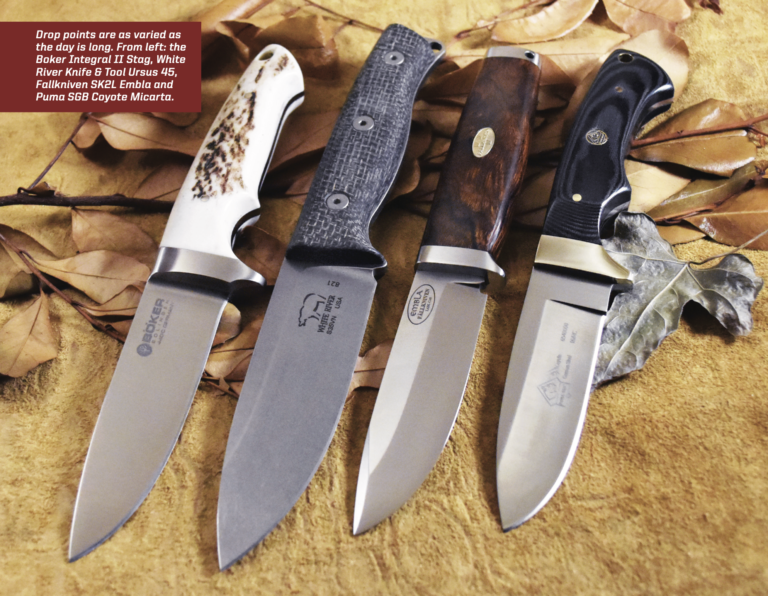
VERY FEW BLADE PATTERNS SHARE THE STYLE AND GRACE OF THE DROP POINT.
Ever since BLADE Magazine Cutlery Hall-Of-Fame® member Bob Loveless popularized the drop-point hunter, there’s been a love affair with the eloquent blade style. Hunters have embraced it—not only for its good looks, but also because of its ability to process game cleanly and efficiently. The drop-point blade also has found a presence on modern tactical knives, attesting to its abilities as an overall effective design.
We’ll stick to hunting/sporting versions and examine a diverse group of drop points from manufacturers around the world. I tested the knives for a variety of chores, including carving and slicing wood, rope and leather, as well as functions particular to a given knife.
1.) SLICING FINE: The Puma SGB Coyote
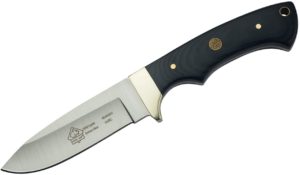
The Puma SGB Coyote Micarta is the budget entry in our quartet. SGB blades are made in Germany, and knife assembly is done in China for cost savings. The Coyote’s 3.75-inch, 440A stainless blade has a deep hollow grind, and its 8.25-inch overall length makes it a medium-sized hunter. Handle construction is full-tang stainless steel with an upper bolster and polished black Micarta® scales that sport a Puma medallion. Weight: 6.14 ounces. A ballistic nylon belt sheath is included. MSRP: $74.99.
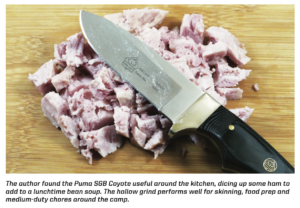
The only knife in the group with a hollow grind, the Coyote is geared toward fine slicing. Testing the blade on leather and rope revealed the 440A stainless steel to be more than adequate, slicing upward in pull-through strokes on harness leather and doubled-up, 3/8- inch synthetic rope in single strokes, both with ease. The blade performed equally well on flat push and pull slices on a wood table top. The handle is comfortable thanks to its nicely finished Micarta scales. I also used it to slice and dice ham to fortify some bean soup, and it handled the prep admirably.
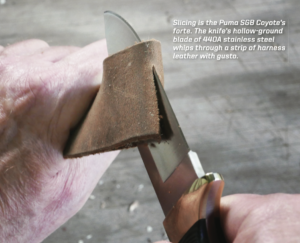
The blade is not going to hold an edge as long as the more expensive steels and those with flat grinds—that’s just the nature of the beast. However, for its price point, it’s an outstanding value that will serve you well for skinning, food prep and medium-duty chores around the camp.
PUMA SGB COYOTE MICARTA SPECS
BLADE LENGTH: 3.75”
BLADE STEEL: 440A stainless
BLADE GRIND: Hollow
HANDLE MATERIAL: Black canvas Micarta®
SPECIAL FEATURES: German-made steel
SHEATH: Ballistic nylon; belt carry
WEIGHT: 6.14 ozs.
OVERALL LENGTH: 8.25”
COUNTRY OF ORIGIN: Germany (blade); China (assembly)
MSRP: $74.99
2.) BUSHCRAFT BEAR: The White River Knife & Tool Ursus 45
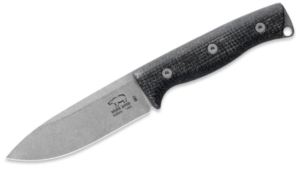
At 9.5 inches overall, the White River Knife & Tool Ursus 45 is a large hunter and the only USA-made drop point in the test bunch. Ursus is Latin for bear, and the “45” is short for the knife’s 4.5- inch blade. The upscale CPM S35VN stainless steel blade has a deep, flat grind topped with a stonewash finish. The 5-inch black burlap Micarta® handle has screw construction, and there’s a lanyard hole in the butt. A brown leather sheath, replete with both a firesteel and loop, is included. MSRP: $250.
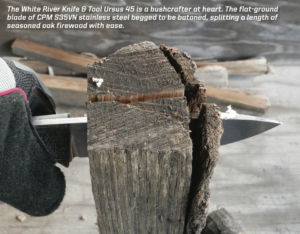
The 45 is a bushcraft knife and makes no bones about it. It screamed to be batoned, and I obliged by battering it through some well-seasoned oak firewood across a roughly 3.5-inch span. The edge of the premium S35VN blade was hardly fazed—this is darned tough steel!—and it also performed well debarking, slicing and digging into some dense boxwood. The blade spine threw sparks off the firesteel surprisingly well. (I find that most prefer tool steel for this function.) It had plenty of firepower. The scales were plenty grippy, and the finger guard and palm swell in the handle made for a strong, secure grip.
It would be hard to find any criticisms about the 45 because it does what it’s supposed to do without complaint. In addition, its price point is well in line with a bushcraft fixed blade with premium steel and above-average fit and finish.
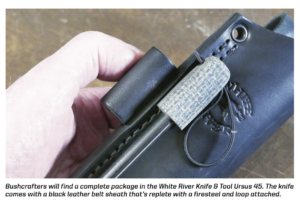
WHITE RIVER KNIFE & TOOL URSUS 45 SPECS
BLADE LENGTH: 4.5”
BLADE STEEL: CPM S35VN stainless
BLADE GRIND: Flat
HANDLE MATERIAL: Black burlap Micarta®
SPECIAL FEATURES: Stonewash finish; firesteel
SHEATH: Brown leather belt sheath w/ firesteel loop
WEIGHT: 8.19 ozs.
OVERALL LENGTH: 9.5”
COUNTRY OF ORIGIN: USA
MSRP: $250
3.) HIGH-END CONVEX: The Fallkniven SK2L Embla
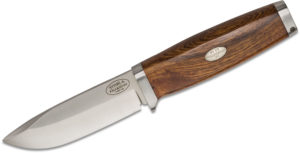
The Fallkniven SK2L Embla is the first of our two higher-end factory drop points.
Made in Sweden, the 8.31-inch Embla derives its ovate, barrel-handled styling from the Scandinavian puukko. It also has a short, stainless steel guard. The 3.94-inch blade is Fallkniven’s laminated CoS stainless steel and is more indicative of the common drop-point style— with the exception of having a convex blade grind. The 4.38-inch handle has a hidden tang and desert ironwood scales sandwiched between a stainless guard and buttcap. A logo emblem rides at center. Manufactured in Japan, the Embla weighs 6.3 ounces and comes with a black leather dangler-style belt sheath. MSRP: $449.95.
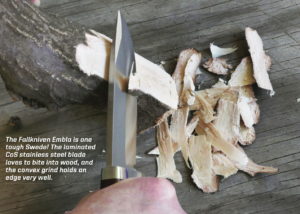
The Embla is the only knife in the group with a convex grind. I’ve mentioned how impressive the company’s laminated CoS stainless steel is in these pages before, and the Embla’s blade didn’t disappoint. I tested it by debarking and slicing into some tough, green, 3-inch-diameter boxwood. It dug in as if it wanted to be there. It also bit into some seasoned oak with equal gusto. The desert ironwood handle is attractive and comfortable, and the sheath is top-shelf.
Many bushcrafters prefer this traditional handle design and use it to great effect. The stainless steel guard, though not deep, is a welcome addition to the handle. The Embla ain’t cheap but it’s first-class from stem to stern. Fallkniven has filled the high-end niche by backing the knife with superb quality.
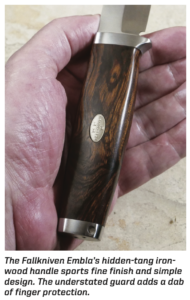
FALLKNIVEN SK2L EMBLA SPECS
BLADE LENGTH: 3.94”
BLADE STEEL: Laminated CoS stainless
BLADE GRIND: Convex
HANDLE MATERIAL: Desert ironwood
SPECIAL FEATURES: Puukko handle design; convex edge
SHEATH: Black leather belt model w/ dangler
WEIGHT: 6.3 ozs.
OVERALL LENGTH: 8.31”
COUNTRY OF ORIGIN: Japan
MSRP: $449.95
4.) SAVORY STEEL: The Boker Integral II Stag
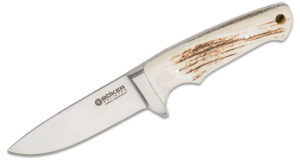
As the name implies, the Boker Integral II Stag features a one-piece design and a handle of an attractive, deep stag. The steel is 440C stainless steel—not unusual in Europe, where its manufacture is a high art. The blade is 4.65 inches long, with a flat grind from edge to spine. The handle design has a deep index finger detent below the solo front bolster. The knife comes with a black leather belt sheath. Weight: 8.47 ounces. Overall length: 9.45 inches. MSRP: $449.
The knife is 100 percent Solingen made, and its overall fit and finish reflect this fact. Real or imagined, integrals have a special feel about them. There’s a “oneness” in the tactile feel between hand and knife.
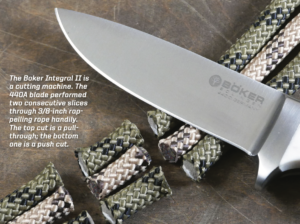
Any preconceived notions I might have had about the blade’s 440C steel were dispelled when I tested it cutting and carving wood, as well as slicing 3/8-inch rappelling rope. In one test, I laid down three lengths of the rope side by side on a flat wood surface and did a pull-through slice immediately followed by a push- through stroke. Only moderate pressure was needed, and the slices were clean as a whistle. The stag handle is comfortable and finely finished—as it should be at this knife’s upper-end price tag.
Will the Integral II’s steel hold an edge as long as a high-end powdered steel? Probably not. It is more a knife to savor than a knife to beat the hell out of, and it does “savoring” in spades. For those who prefer—and can afford—a beautifully crafted knife, this is one you’ll enjoy using.
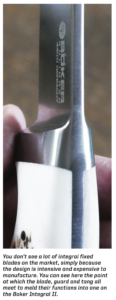
BOKER INTEGRAL II STAG SPECS
BLADE LENGTH: 4.65”
BLADE STEEL: 440C stainless
BLADE GRIND: Flat
HANDLE MATERIAL: Deer stag
SPECIAL FEATURES: Integral design
SHEATH: Black leather belt model WEIGHT: 8.47 ozs.
OVERALL LENGTH: 9.45”
COUNTRY OF ORIGIN: Germany MSRP: $449
Editor’s note: Loveless always referred to the knife as a dropped hunter because the point of the blade dropped below the plane of the blade’s spine. Somewhere along the way, knife writers and those in the knife community started calling it a drop-point hunter or simply a drop point, and the name stuck.
 NEXT STEP: Download Your Free KNIFE GUIDE Issue of BLADE Magazine
NEXT STEP: Download Your Free KNIFE GUIDE Issue of BLADE Magazine
BLADE’s annual Knife Guide Issue features the newest knives and sharpeners, plus knife and axe reviews, knife sheaths, kit knives and a Knife Industry Directory.Get your FREE digital PDF instant download of the annual Knife Guide. No, really! We will email it to you right now when you subscribe to the BLADE email newsletter.






